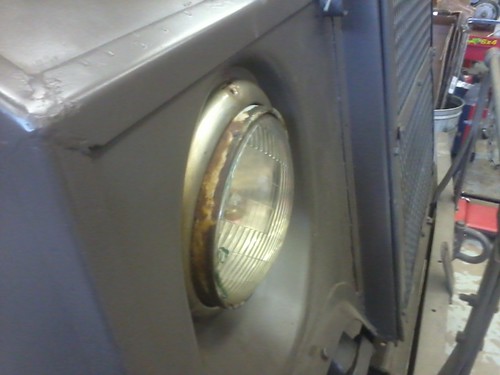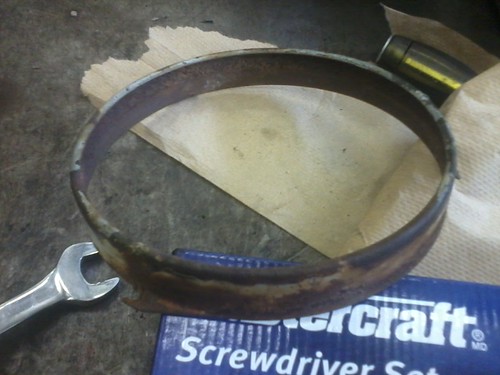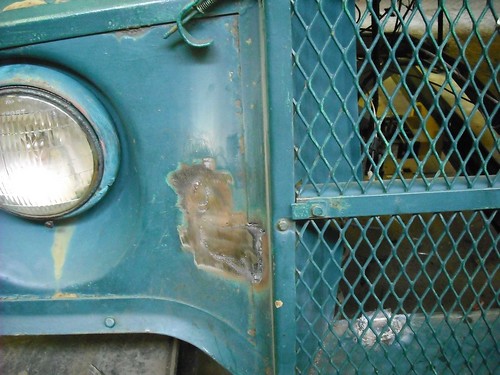
 |
|
|
|
#1
|
||||
|
||||
|
I have an original bow off a 2A1 but they're a bit different to the other 15 cwt bows. They are made in two pieces and welded together at the centre.
__________________
1940 Cab 11 C8 Wireless with 1A2 box & 11 set 1940 Cab 11 C8 cab and chassis 1940 Cab 11 C15 with 2A1 & Motley mount & Lewis gun 1940 Cab 11 F15A w/ Chev rear ends 1941 Cab 12 F15A 1942-44 Cab 13 F15A x 5 1942 cab 13 F15A with 2B1 box 1943 cab 13 F15A with 2H1 box 1943 Cab 13 C8A HUP 1944 Cab 13 C15A with 2C1 box 1943 Cletrac M2 High Speed Tractor MkII Bren gun carrier chassis x 2 |
|
#2
|
|||
|
|||
|
Still should work for measurements and/or a template
|
|
#3
|
|||
|
|||
|
So....cletrac, think you could make a template for me?
So the students are rewiring the dash panel and are using the Chey wiring diagram. On the diagram it it shows a headlight beam indicator. Any body have an idea what this is or where it is on a 1942 chev dash. Pictures would be really helpful. 
|
|
#4
|
||||
|
||||
|
Hi Joe - encountered this many years ago and came up with the following.
Dim Lights Bright Lights When I first started restoring Chevrolet instrument panels, as usual, I obtained the best NOS speedometer and instrument faces to replicate. My first speedometer face just happened to be a “Bright Light” face and several old panels I obtained were all the same. Lately though the ones I have been obtaining have a “Dim Light” face. Of course I didn’t discover this immediately until I was comparing instrument serial numbers and found that I had two different numbers for the speedometer face. Shock, horror, where did this “Dim Light” come from and what was its history. I consulted one of my guru contacts who told me the following. Prior to about 1938 there was basically no beam indication in a speedometer. In about that year Pontiac and Chevrolet built in a low beam indicator and that was described on the speedometer face. In the late 1940s, apparently after many complaints from army drivers, the wiring was changed to allow a high beam indication and that was reflected on the new speedometer face. I do not doubt the veracity of this story but would be interested for any corroboration. As an aside apparently the British were high beam indicators right from the start. BTW your replacement switch and plate are en-route.  Bob Bob
__________________
Chevrolet Blitz Half-Track Replica - Finished and Running Ford F15 - unrestored Ford F15A X 2 - unrestored Website owner - salesmanbob.com |
|
#5
|
|||
|
|||
|
So today the students were test fitting a headlight, but it seems to not fit correctly and I know that they did fit when the vehicle was first dropped off. They seem to be sticking out a bit too much, especially compared to the original pictures. Any ideas what is wrong?
     
|
|
#6
|
|||
|
|||
|
The pattern in the lens appears to be twisted compared to the original. I can think of 3 possible causes for this. Either the headlight buckets are twisted in the nose assembly of the truck, the inner part of the bucket is twisted with respect to the outer or the sealed beam is twisted in the bucket assembly.
The outer bucket is assymetric (as is the cutout in the truck's nose) and should only be possible to install correctly with one adjusting screw at the top and the other on the side. Check carefully to be sure the correct screw is at the top. I don't recall whether the sideways screw is on the left or right. Similarly the layout of adjusting screws and tension springs should only let the inner bucket fit nicely in one orientation in the outer bucket. The inner bucket should ride smoothly on the rounded inner rim within the outer bucket. Finally, it should only be possible to fit the bulb one way in the inner of the bucket due to the mounting lugs on the back of the sealed beam needing to fit into recesses on the inner bucket. Any other orientation will make the bulb sit unevenly (and twisted) with only one lug in its recess or possibly just sit far forward in the bucket, not well restrained in rotational alignment. In your "after" photo the securing screw is at the top of the exterior (rounded) trim ring, in the "before" photo it is at the bottom. I believe the bottom is "normal". |
|
#7
|
|||
|
|||
|
.....bulging eye ball is usually a thyroid problem....
....but would never occur on a Chev...
__________________
Bob Carriere....B.T.B C15a Cab 11 Hammond, Ontario Canada |
 |
| Thread Tools | |
| Display Modes | |
|
|